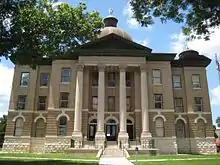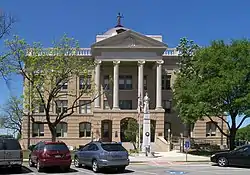Charles Henry Page
Charles Henry Page (1876–1957) was an American architect. He and his brother Louis Charles Page (1883–1934) founded the Texas firm of Page Brothers, Architects (also known as C. H. Page & Bro.). The firm achieved great recognition when they were commissioned to design the Texas State Building for the 1904 Louisiana Purchase Exposition (informally known as the St. Louis World's Fair).[1] The Pages also designed many courthouses and other buildings across Texas.

Early life and career
Page was the son of an English immigrant Stone mason. Page was born in St. Louis, Missouri. His family moved to Texas when he was ten years old so his father could work on the Texas State Capitol. He attended public school and worked with his father in the construction industry.
Page apprenticed with several architects and then began his own practice at the age of 19 with the firm Makin and Page. Page left that firm and began an independent practice as C. H. Page, Jr. His brother Louis soon joined him, and they formed Page Brothers, Architects in 1898. The firm became one of the leading firms specializing in public projects such as public schools and courthouses.
Page's son Charles Henry Page, Jr. was born in 1910 in Austin. He received his bachelor's degree in architecture in 1932 from the University of Texas at Austin. After Louis's death in 1934, Page, Jr. joined the practice. In 1936, he became a partner and the firm name was changed to C.H. Page & Son. After the death of Page, Sr. (the father, though sometimes also referred to as C. H. Page, Jr.) in 1957, Page, Jr. continued to practice for several years.[2]
Louis Charles Page also had a son, Louis Charles Page, Jr. (1909–1981), who became an architect. He and college roommate Louis Southerland (1906–1994) formed Page and Southerland in 1935 in Austin. Page and Southerland designed many of the monuments placed around the state to commemorate the Texas Centennial. They were joined by Louis's brother George in 1939 and the name was expanded to Page Southerland Page. The company changed its name to just Page in 2013.[3]
Texas courthouses
The brothers designed numerous public buildings in Texas, including the Anderson, Chambers, Fort Bend, Hays, Hunt and Williamson county courthouses. The 1908 Fort Bend County Courthouse was listed on the National Register of Historic Places (NRHP) in 1980.[4] The 1908 Hays County Courthouse was added to the NRHP in 1992.[5] The 1911 Williamson County Courthouse is a contributing property to the 1977 NRHP designation of the Williamson County Courthouse Historic District.[6] The 1914 Anderson County Courthouse was added to the NRHP in 1992.[7] The 1929 Hunt County Courthouse was placed on the NRHP in 1996.[8] Page also designed the 1936 Austin federal courthouse, which was added to the NRHP in 2001.[9] The 1937 Orange County Courthouse replaced the 1898 courthouse.[10]
Other Designs
Page designed the station at Crowley, Louisiana, built in 1907 for the Colorado Southern, New Orleans and Pacific Railroad[11] as well as the city hall buildings in Brownsville, Mexia and Eagle Lake.[3]
Personal
Page lived in the Pemberton Heights district of Austin.[12] He died in 1957 and is buried at Oakwood Cemetery Annex in Austin.[13]
Gallery
 Fort Bend County Courthouse, Texas
Fort Bend County Courthouse, Texas Williamson County Courthouse, Texas
Williamson County Courthouse, Texas Anderson County Courthouse, Texas
Anderson County Courthouse, Texas.jpg.webp) Hunt County Courthouse, Texas
Hunt County Courthouse, Texas Orange County Courthouse, Texas
Orange County Courthouse, Texas United States Courthouse, Austin, Texas
United States Courthouse, Austin, Texas Railroad Depot, Crowley, Louisiana
Railroad Depot, Crowley, Louisiana
References
- Texas School Journal, Volume 20. 1902. p. 427.
- "C. H. Page & Son Records, 1893–1970". Texas Archival Resources Onlne. Austin History Center. Retrieved 9 March 2019.
- "History". Page. Page Southerland Page, Inc. Retrieved 9 March 2019.
- "Fort Bend County Courthouse". Texas Historical Commission. Retrieved September 2, 2013.
- "Hays County Courthouse". Texas Historical Commission. Retrieved September 2, 2013.
- "Williamson County Courthouse Historical District". Texas Historical Commission. Retrieved September 2, 2013.
- "Anderson County Courthouse". Texas Historical Commission. Retrieved September 2, 2013.
- "Hunt County Courthouse". Texas Historical Commission. Retrieved September 2, 2013.
- "U.S. Courthouse, Austin, TX". General Services Administration. Retrieved 3 August 2016.
- "Orange County Courthouse". Texas Escapes. Blueprints For Travel, LLC. Retrieved September 2, 2013."Orange County Courthouse". Texas Historical Commission. Retrieved September 3, 2013.
- "Historic Colorado Southern Railroad Depot" in SAH Archipedia, eds. Gabrielle Esperdy and Karen Kingsley, Charlottesville: UVaP, 2012—, http://sah-archipedia.org/buildings/LA-01-AC6. Accessed 2016-08-13.
- Cash, Elizabeth A; Deaderick, Suzanne B (2012). Austin's Pemberton Heights. Arcadia Publishing. p. 119. ISBN 978-0738595894.
- Austin Genealogical Society
External links
| Wikimedia Commons has media related to Charles Henry Page. |